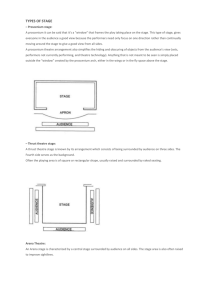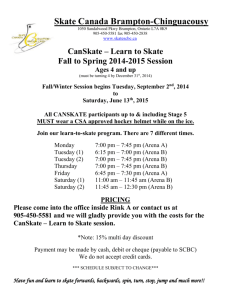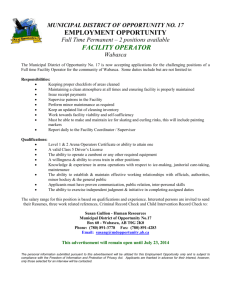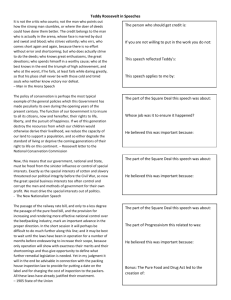Major Municipal Sport & Recreation Facility Inventory Phases One
advertisement
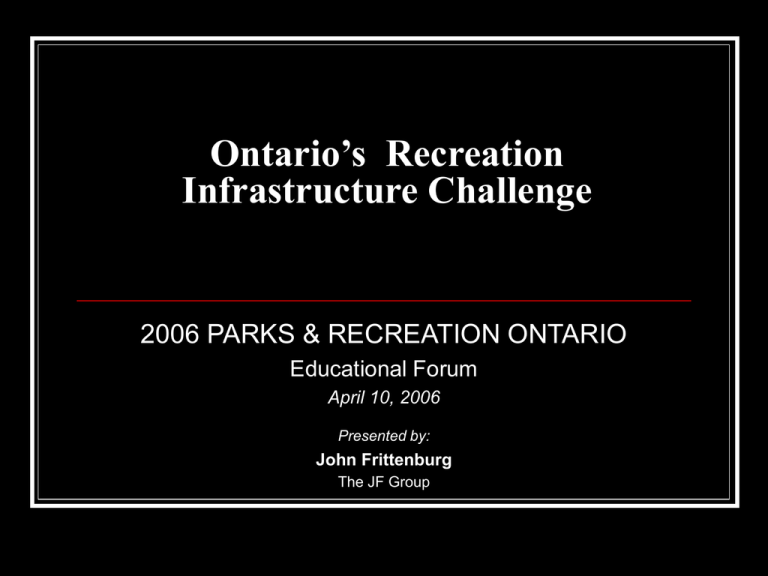
Ontario’s Recreation Infrastructure Challenge 2006 PARKS & RECREATION ONTARIO Educational Forum April 10, 2006 Presented by: John Frittenburg The JF Group TODAY’S AGENDA Sport and Recreation Facility Inventory project Why is infrastructure important Implications of aging inventory Uses of the facility data RELATED INFLUENCES Facility time is at a premium Designs have changed Capital funding is limited Consumer expectations are rising Political resistance to decommissioning ABOUT THE SPORT AND RECREATION FACILITY INVENTORY PROJECT MULTIPLE PHASED PROJECT Major municipal facilities Collect and analyze data Determine capital cost implications Other municipal facilities Facilities in other sectors Operating and use trends PROJECT ADVISORS Steering Committee PRO, ORFA, OPA, OTC Working Group MTR, YMCA, OFC, Private Sector PROJECT SCOPE Major Facilities arenas pools (indoor and outdoor) community centres Other Facilities gymnasia curling rinks fitness centres outdoor rinks splash pads wading pools golf courses down hill skiing RESPONSE RATE 96% - 409 of 428 municipalities Non-respondents – mostly counties, townships and districts Sample represents 99% of provincial population ANALYSIS CATEGORIES Location Municipal population Facility age MAJOR MUNICIPAL FACILITIES Community Centres 1,370 Arena 677 Indoor Pools 234 Outdoor Pools 279 LIFE CYCLE STATUS – ALL MAJOR FACILITIES DEVELOPMENT TRENDS Chart 2 Arena Life Cycle Status Quads Triples 1 - 10 years 11 - 24 years Twin Pads 25 - 49 years 50 + years Single Pad 0% 20% 40% 60% 80% Proportion of Public Inventory 100% COMMUNITY CENTRE LIFE CYCLE STATUS Chart 3 Com m unity Centre Life Cycle Status 50 + years 19% 1 - 10 years 14% 11 - 24 years 22% 25 - 49 years 45% ARENA CONFIGURATIONS Chart 5 Proportion of Provincial Arena Inventory By Type Quad (+) 1% Twin 15% Triple 1% Single 83% ARENA CONFIGURATION BY COMMUNITY SIZE ARENA LIFE CYCLE STATUS Chart 2 Arena Life Cycle Status Quads Triples 1 - 10 years 11 - 24 years Twin Pads 25 - 49 years 50 + years Single Pad 0% 20% 40% 60% 80% Proportion of Public Inventory 100% POOL LIFE CYCLE STATUS Chart 8 Provincial Inventory Indoor Pool by Life Cycle Status 50 + years 2% 25 - 49 years 50% 1 - 10 years 20% 11 - 24 years 28% POOL STATUS BY COMMUNITY SIZE SUMMARY OF INVENTORY FINDINGS Average Age Pools Arenas Community Centres 27 years 33 years 32 years 30% - 50% of stock nearing end of life Small communities have immediate crisis APPROACH TO COST ESTIMATE Establish facility parameters Determine capital repair and replacement assumptions Apply assumptions to facility data COST THRESHOLDS (2005 $) Arenas single twin Quad $7.5 M $13.2 M $21 M Pool $5.6 M Community Centre $1.5 M FACILITY CAPITAL REPAIR FUNDING FORMULA Percentage of 2005 Capital Construction Cost 5% 0 Years 40% 10 Years 50% 25 Years Age of Facility 130% 49 Years 50+ Years OBSERVATIONS Municipalities are significant facility providers Inventories are critically old Small communities have oldest arenas Improvements needed beyond age related requirements INFRASTRUCTURE PROGRAM SUGGESTIONS Balance recreation, physical activity, leisure and sport facilities Multi-year program Consult with sector Complement existing F/P – T programs PROGRAM SHOULD RECOGNIZE: Competing municipal capital priorities Operating cost – part of local contribution Assistance required for new and existing facilities Life cycle maintenance program is required APPLICATION TO CAPITAL PLANNING Facility types by age Estimated replacement cost Repair cost factor Capital repair strategy Capital reserve contribution FOR EXAMPLE: ASSUME YOU HAVE 1 Single pad arena 30 years old 1 Twin pad arena 15 years old 1 Pool 2 community halls 9 years old 12 years old CAPITAL REPLACEMENT REQUIREMENTS Arenas $9.03 M Pool $280,000 Community Centres $1.2 M CAPITAL RESERVE STRATEGIES Respond to crisis Building audits Annual contribution formula Funding program catalyst RESERVE FUND FORMULA Life Cycle Contribution Position Year 1 – 10 1% +50% Year 11 – 25 2% -25% Year 26 – 50 2% Even IMPLICATIONS OF WELL FUNDED RESERVE Facilities constantly maintained Lower operating costs More cost certainty Less bandages Fewer major surprises QUESTIONS AND ANSWERS
